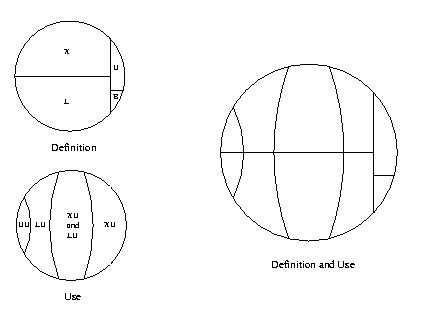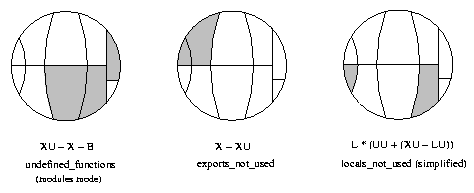![[Ericsson AB]](min_head.gif)
![[Ericsson AB]](min_head.gif)
Xref is a cross reference tool that can be used for finding dependencies between functions, modules, applications and releases. It does so by analyzing the defined functions and the function calls.
In order to make Xref easy to use, there are predefined analyses that perform some common tasks. Typically, a module or a release can be checked for calls to undefined functions. For the somewhat more advanced user there is a small, but rather flexible, language that can be used for selecting parts of the analyzed system and for doing some simple graph analyses on selected calls.
The following sections show some features of Xref, beginning with a module check and a predefined analysis. Then follow examples that can be skipped on the first reading; not all of the concepts used are explained, and it is assumed that the reference manual has been at least skimmed.
Assume we want to check the following module:
-module(my_module).
-export([t/1]).
t(A) ->
my_module:t2(A).
t2(_) ->
true.
Cross reference data are read from BEAM files, so the first step when checking an edited module is to compile it:
1> c(my_module, debug_info).
./my_module.erl:10: Warning: function t2/1 is unused
{ok, my_module}
The debug_info option ensures that the BEAM file
contains debug information, which makes it possible to find
unused local functions.
The module can now be checked for calls to deprecated functions, calls to undefined functions, and for unused local functions:
2> xref:m(my_module)
[{deprecated,[]},
{undefined,[{{my_module,t,1},{my_module,t2,1}}]},
{unused,[{my_module,t2,1}]}]
m/1 is also suitable for checking that the
BEAM file of a module that is about to be loaded into a
running a system does not call any undefined functions. In
either case, the code path of the code server (see the module
code) is used for finding modules that export externally
called functions not exported by the checked module itself, so
called library
modules.
In the last example the module to analyze was given as an
argument to m/1, and the code path was (implicitly)
used as library
path. In this example an xref server will be used,
which makes it possible to analyze applications and releases,
and also to select the library path explicitly.
Each Xref server is referred to by a unique name. The name is given when creating the server:
1> xref:start(s).
{ok,<0.27.0>}
Next the system to be analyzed is added to the Xref server.
Here the system will be OTP, so no library path will be needed.
Otherwise, when analyzing a system that uses OTP, the OTP
modules are typically made library modules by
setting the library path to the default OTP code path (or to
code_path, see the reference manual). By
default, the names of read BEAM files and warnings are output
when adding analyzed modules, but these messages can be avoided
by setting default values of some options:
2> xref:set_default(s, [{verbose,false}, {warnings,false}]).
ok
3> xref:add_release(s, code:lib_dir(), {name, otp}).
{ok,otp}
add_release/3 assumes that all subdirectories of the
library directory returned by code:lib_dir() contain
applications; the effect is that of reading all
applications' BEAM files.
It is now easy to check the release for calls to undefined functions:
4> xref:analyze(s, undefined_function_calls).
{ok, [...]}
We can now continue with further analyses, or we can delete the Xref server:
5> xref:stop(s).
The check for calls to undefined functions is an example of a predefined analysis, probably the most useful one. Other examples are the analyses that find unused local functions, or functions that call some given functions. See the analyze/2,3 functions for a complete list of predefined analyses.
Each predefined analysis is a shorthand for a query, a sentence of a tiny language providing cross reference data as values of predefined variables. The check for calls to undefined functions can thus be stated as a query:
4> xref:q(s, "(XC - UC) || (XU - X - B)").
{ok,[...]}
The query asks for the restriction of external calls except the
unresolved calls to calls to functions that are externally used
but neither exported nor built-in functions (the ||
operator restricts the used functions while the |
operator restricts the calling functions). The - operator
returns the difference of two sets, and the + operator to
be used below returns the union of two sets.
The relationships between the predefined variables
XU, X, B and a few
others are worth elaborating upon.
The reference manual mentions two ways of expressing the set of
all functions, one that focuses on how they are defined:
X + L + B + U, and one
that focuses on how they are used:
UU + LU + XU.
The reference also mentions some facts about the
variables:
F is equal to L + X (the defined functions
are the local functions and the external functions);
U is a subset of XU (the unknown functions
are a subset of the externally used functions since
the compiler ensures that locally used functions are defined);
B is a subset of XU (calls to built-in
functions are always external by definition, and unused
built-in functions are ignored);
LU is a subset of F (the locally used
functions are either local functions or exported functions,
again ensured by the compiler);
UU is equal to
F - (XU + LU) (the unused functions
are defined functions that are neither used externally nor
locally);
UU is a subset of F (the unused functions
are defined in analyzed modules).
Using these facts, the two small circles in the picture below can be combined.

It is often clarifying to mark the variables of a query in such
a circle. This is illustrated in the picture below for some of
the predefined analyses. Note that local functions used by local
functions only are not marked in the locals_not_used
circle.

The module check and the predefined analyses are useful, but limited. Sometimes more flexibility is needed, for instance one might not need to apply a graph analysis on all calls, but some subset will do equally well. That flexibility is provided with a simple language. Below are some expressions of the language with comments, focusing on elements of the language rather than providing useful examples. The analyzed system is assumed to be OTP, so in order to run the queries, first evaluate these calls:
xref:start(s).
xref:add_release(s, code:root_dir()).
xref:q(s, "(Fun) xref : Mod").
xref module.
xref:q(s, "xref : Mod * X").
xref module. The first
operand of the intersection operator * is implicitly
converted to the more special type of the second operand.
xref:q(s, "(Mod) tools").
tools application.
xref:q(s, '"xref_.*" : Mod').
xref_.
xref:q(s, "# E | X ").
xref:q(s, "XC || L ").
xref:q(s, "XC * LC").
xref:q(s, "(LLin) (LC * XC)").
xref:q(s, "(XLin) (LC * XC)").
xref:q(s, "XC * (ME - strict ME)").
xref:q(s, "E ||| kernel").
kernel application.
xref:q(s,
"closure E | kernel || kernel").
kernel
application. Both the calling and the used functions of
indirect calls are defined in modules of the kernel
application, but it is possible that some functions outside
the kernel application are used by indirect calls.
xref:q(s, "{toolbar,debugger}:Mod of ME").
toolbar to
debugger, if there is such a chain, otherwise
false. The chain of calls is represented by a list of
modules, toolbar being the first element and
debugger the last element.
xref:q(s, "closure E | toolbar:Mod || debugger:Mod").
toolbar to
functions in debugger.
xref:q(s, "(Fun) xref -> xref_base").
xref to xref_base.
xref:q(s, "E * xref -> xref_base").
xref:q(s, "E || xref_base | xref").
xref:q(s, "E * [xref -> lists, xref_base -> digraph]").
xref to lists, and
all function calls from xref_base to digraph.
xref:q(s, "E | [xref, xref_base] || [lists, digraph]").
xref and xref_base
to lists and digraph.
xref:q(s, "components EE").
xref:q(s,
"X * digraph * range (closure (E | digraph) | (L * digraph))").
digraph module
used (in)directly by some function in digraph.
xref:q(s, "L * yeccparser:Mod - range (closure (E |
yeccparser:Mod) | (X * yeccparser:Mod))").
The list representation
of graphs is used analyzing direct calls,
while the digraph representation is suited for analyzing
indirect calls. The restriction operators (|, ||
and |||) are the only operators that accept both
representations. This means that in order to analyze indirect
calls using restriction, the closure operator (which creates the
digraph representation of graphs) has to been
applied explicitly.
As an example of analyzing indirect calls, the following Erlang
function tries to answer the question:
if we want to know which modules are used indirectly by some
module(s), is it worth while using the function graph rather
than the module graph? Recall that a module M1 is said to call
a module M2 if there is some function in M1 that calls some
function in M2. It would be nice if we could use the much
smaller module graph, since it is available also in the light
weight modules mode of Xref servers.
t(S) ->
{ok, _} = xref:q(S, "Eplus := closure E"),
{ok, Ms} = xref:q(S, "AM"),
Fun = fun(M, N) ->
Q = io_lib:format("# (Mod) (Eplus | ~p : Mod)", [M]),
{ok, N0} = xref:q(S, lists:flatten(Q)),
N + N0
end,
Sum = lists:foldl(Fun, 0, Ms),
ok = xref:forget(S, 'Eplus'),
{ok, Tot} = xref:q(S, "# (closure ME | AM)"),
100 * ((Tot - Sum) / Tot).
Comments on the code:
(Mod) (closure E | AM), but then we
would have to represent all of the transitive closure of E in
memory. Instead the number of indirectly used modules is
found for each analyzed module, and the sum over all modules
is calculated.
digraph
representation of the function graph for use in many
queries. The reason is efficiency. As opposed to the
= operator, the := operator saves a value for
subsequent analyses. Here might be the place to note that
equal subexpressions within a query are evaluated only once;
= cannot be used for speeding things up.
Eplus | ~p : Mod. The | operator converts
the second operand to the type of the first operand. In this
case the module is converted to all functions of the
module. It is necessary to assign a type to the module
(: Mod), otherwise modules like kernel would be
converted to all functions of the application with the same
name; the most general constant is used in cases of ambiguity.
# that counts the elements of the operand is
used. It cannot be applied to the digraph representation
of graphs.
When the Erlang function t/1 was applied to an Xref
server loaded with the current version of OTP, the returned
value was close to 84 (percent). This means that the number
of indirectly used modules is approximately six times greater
when using the module graph.
So the answer to the above stated question is that it is
definitely worth while using the function graph for this
particular analysis.
Finally, note that in the presence of unresolved calls, the
graphs may be incomplete, which means that there may be
indirectly used modules that do not show up.